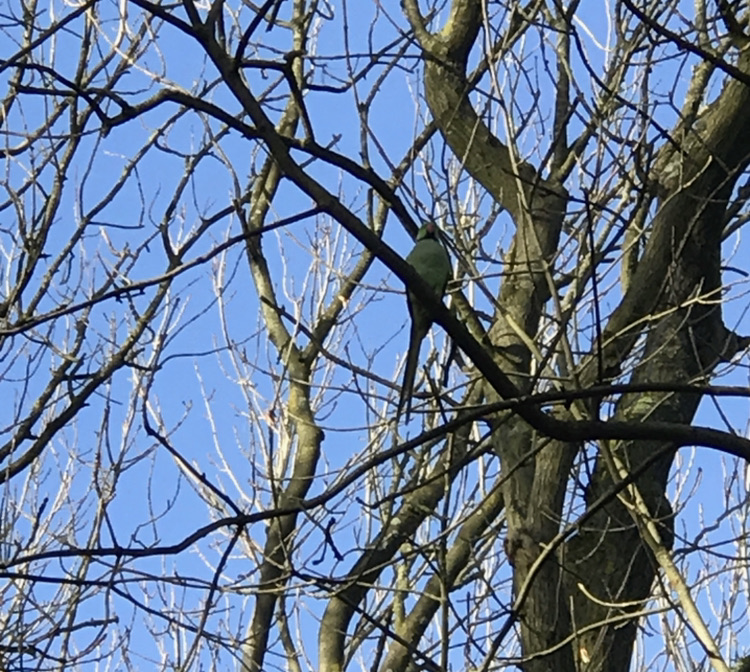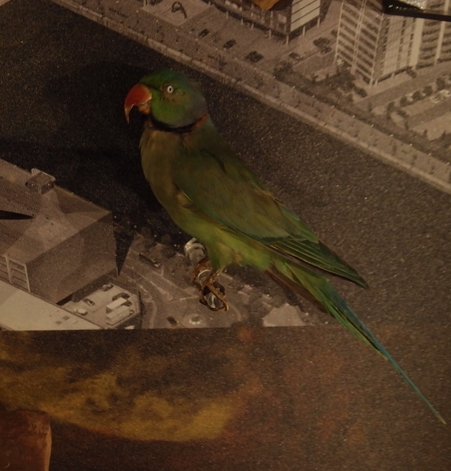On one of my regular walks at Whitworth park a couple of weeks ago I noticed a type of bird in the trees that looked a lot different to the Pigeons that you might expect to see. I thought it was strange to see a bird with bright green feathers in the middle of cold rainy Manchester so I knew I had to look into it further. My first thought was that the Parakeet I saw must be someone’s pet that had escaped and that it shouldn’t be there at all.

My curiosity lead me to find out that they were in fact wild and that they had been living and breeding in the UK for quite some time.
There are over 100 species of Parakeets in the world, mostly native to tropical regions of the world in Africa, Asia, Australasia and South America, so what exactly is a whole family of them doing in a park in Manchester in mid-February?
The particular species I spotted was a Ring-necked Parakeet (Psittacula krameri), which also happens to be the only naturalised Parakeet species in the UK. This species, native to sub-Saharan Africa and Southern Asia is now the northern-most breeding Parrot species in the world. Since the 19th Century, it has made itself at home in many countries across Central Europe including France, Germany, Belgium and most abundantly, the UK. The question is how have they managed to adapt and become such successful feral birds around Europe, and why are they here in they here in the first place?
A popular pet in Europe since the 19th century, it is widely accepted that released and escaped individuals have contributed to the feral population. The fact that they have few natural predators in Europe and their food is easily available at bird feeding stations in parks and gardens has allowed these early individuals to thrive and therefore survive to reproduce at a rapid rate. A 2015 count across 10 European countries concluded that there were 85,220 individuals in the wild, with 31,100 being in the UK. This is rather impressive as they weren’t established as a wild species in the UK until the 1970s. It’s adaptation to the Himalayan environments in South Asia have allowed it to thrive in the cold winters of Europe, even Manchester.
As with most things in natural science, there are some rather speculative theories on how they have been able to spread across the UK. Some people may believe that they have become successful after they were released during the filming of the 1951 film “The African Queen” in Shepperton, Surrey or that it is due to the fact that Jimi Hendrix let a pair go during a gig in London in the 1960s.

References
- Cooper, M., 2021. Wild theories that may explain why there so many parakeets in Manchester. [online] Manchester Evening News. Available at: <https://www.manchestereveningnews.co.uk/news/greater-manchester-news/many-parakeets-south-manchester-wild-15642144>.
- News.bbc.co.uk. 2021. BBC NEWS | Magazine | How do parakeets survive in the UK?. [online] Available at: <http://news.bbc.co.uk/1/hi/magazine/6478911.stm>.
- Pârâu, L., Strubbe, D., Mori, E., Menchetti, M., Ancillotto, L., Kleunen, A., White, R., Luna, Á., Hernández-Brito, D., Louarn, M., Clergeau, P., Albayrak, T., Franz, D., Braun, M., Schroeder, J. and Wink, M., 2016. Rose-ringed Parakeet Psittacula krameri Populations and Numbers in Europe: A Complete Overview. The Open Ornithology Journal, 9(1), pp.1-13.
- Petmd.com. 2021. All About Budgerigars | PetMD. [online] Available at: <https://www.petmd.com/bird/care/all-about-budgerigars>.
Filed under: Uncategorized |




Leave a comment